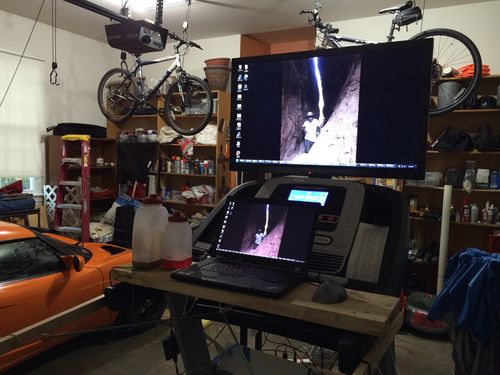Treadmill Desk
From Fellrnr.com, Running tips
Revision as of 15:16, 7 January 2016 by User:Fellrnr (User talk:Fellrnr | contribs) (Created page with "File:Improvised Treadmill Desk.jpg|right|thumb|500px| this is my improvised treadmill desk, simply using a plank between the arms of the treadmill. This isn't a terribly saf...")
A Treadmill Desk has the potential of allowing you to exercise while working. I believe it's a viable option, but there are some important caveats.
- You can cover a lot of extra miles while working, so it's easy to overdo it. Walking at 2 mph for 8 hours would give you 16 miles a day, or 80 miles in a five-day work week. This is a lot of miles; more than enough to produce an injury. This means it's important to build up your mileage gradually, and monitoring your body for signs of impending disaster. If you're used to running high mileages, you may be more at risk than most. Running and walking use different muscles, and a highly trained runner is a specialist that is vulnerable to unaccustomed stresses. I would recommend starting off with walking for 15 minutes per hour for up to 4 hours per day, giving one hour of walking. Build it up from there cautiously.
- The stress of walking is far more dependent on pace than running. This is because the energy required to run a given distance is nearly constant, so running twice as fast requires twice the intensity, a simple linear relationship. Walking on the other hand requires a disproportionate amount of energy as the speed increases. People will naturally start running as the pace increases because of this. As a result, a seemingly small increase in pace incurs a surprisingly large increase in intensity. Biomechanically it's also a lot harder to walk faster, and the impact stress rises dramatically. This means you need to be cautious with your pace; I'd recommend starting at 1.0 to 1.5 mph. Build up the distance first, then the pace, and avoid increasing both together. See Calories burned running and walking for more details.
- Phone calls are pretty easy while walking on a treadmill, though the noise can be an issue. My running treadmill is quite noisy, though this is not too bad with a good headset. The noise is both from the motor and from the sound of my feet landing.
- Looking at a PC screen is trickier than a phone call, as your head will bob up and down and sway from side to side as you walk. This can make it hard to read the screen, but it can also cause some motion sickness. I've found that a larger screen further away helps enormously with the motion sickness. I've been using a 40-inch screen at about 3 feet distance, and this solved most of my motion sickness issues.
- Typing and using a mouse are the hardest part of a treadmill desk. I found a mouse to be impractical for most tasks, but a trackball works fine. I love the Kensington Expert Trackball. Typing is more of an issue, and a large keyboard with well spaced keys helps if you're a touch typist. I've no idea how well you'd do if you don't touch type, as looking at the keyboard to type is likely to cause motion sickness and neck strain. Keeping the pace slow helps with the ease of typing. Of course, using dictation software is another option that can work really well.
Which Treadmill?
Which treadmill to choose is tricky, but here are my initial thoughts.
- I've used my running Treadmill, the ProForm Pro 2000 with a plank of wood over the arms. This treadmill has withstood fairly outrageous abuse, and while it's showing signs of wear, it's going strong. It's far from ideal as a treadmill desk, and there's a real risk of injury if the plank falls, dumping the wood and laptop (plus wires) into your path. On the other hand, if you have a treadmill for running, this is an easy way of trying it out to see how you get on without investing large sums of money.
- I've only found one treadmill that looks like it's designed for office use, the iMovR ThermoTread GT. This claims to be much quieter, smaller, and use more office friendly controls. Unfortunately, I've found few credible reviews, but this seems to be the prime candidate. The main disadvantage I've noted is that its maximum speed is 2.5 MPH, which is enough for most users, but I could see times when I'd like to move faster. It requires you to have a separate standing desk. If you're not already standing to work, I'd recommend starting there before considering a walking desk. (I have the electrically adjustable Geek Desk that I love.)
- Most other treadmills seem to be focused on gym use, with minor modifications for office use.
- If you want a treadmill with a desk built in, the Lifespan TR5000 DT5 or the Proform Thinline Desk Treadmill both seem highly rated. The ProForm could double as a reasonable running treadmill if you need something for to fulfill both roles, but as is often the way, it's a compromise.
- If you already have a standing desk, LifeSpan does a range of Under Desk Treadmills. The base TR800-DT3 only allows for 3 hours/day use, and the TR1200 is limited to 6 hours/day. You have to move up to the TR5000 to get all day use.
